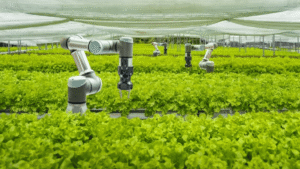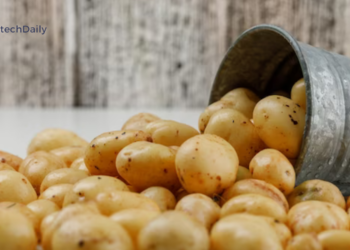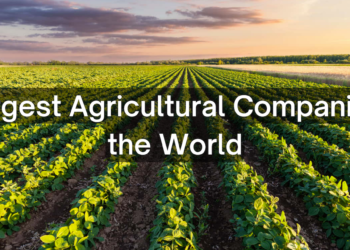With the rise of big data, the digitization of agriculture, and the development of artificial intelligence and machine learning, we are now starting to see more and more new developments in the world of AgroTech.
These new technologies are changing how farmers grow crops, take care of livestock, monitor their fields, and even sell their products. They’re also making it easier for small-scale farmers to compete with large-scale agribusinesses.
These include everything from smart tools for farm management to apps that help you better understand your plants and crops.
Smart Farming Tools
In recent years, smart farming tools have become increasingly popular. These tools use artificial intelligence and machine learning to optimize field operations and increase efficiency. Some of the most common tools in this category include sensors, data analysis systems, and mobile apps. For example, sensors in the field send data to a data analysis system.

This system can then use artificial intelligence to make recommendations, such as suggesting when to apply fertilizer based on the crop’s growth. Another example of a smart farming tool is an app that manages irrigation and other field operations. This allows farmers to operate their fields more efficiently and earn more profit.
Smart Farming Platforms
Smart farming platforms support smart farming tools. By connecting sensors, data analysis systems, artificial intelligence, and other tools, a platform helps farmers manage their operations and increase efficiency. A good example of a smart farming platform is FarmConnect.
This platform allows farmers to control their equipment, manage their crop data, and operate their fields remotely. Another example of a smart farming platform is the MyAgroCloud platform from Blue River. This platform helps farmers manage their operations, track their products, and increase their profits by providing smart tools and farming operations.
Artificial Intelligence and Machine Learning in Agriculture
The rise of big data, the development of artificial intelligence, and machine learning in the agricultural sector have led to tremendous growth in the use of these technologies. This has led to the development of artificial intelligence and machine learning for agriculture.
Artificial intelligence, for example, uses algorithms to help analyze and understand data sets. This can be used to help identify crop diseases and forecast weather and other environmental factors. Machine learning, on the other hand, uses algorithms that help analyze data sets. These algorithms can then be “trained” on data sets to generate predictions and recommendations.
Machine learning can be used to help farmers manage their operations, forecast weather, and other factors, and control their equipment. Artificial intelligence, on the other hand, can be used to help identify crop diseases and forecast weather and other factors.
Internet of Things (IoT)
The Internet of Things (IoT) is a combination of sensors, networks, and artificial intelligence that helps boost productivity in the agricultural sector. This is possible because it wirelessly connects machines and devices to the internet. A good example of an IoT system is Agri-Grid.
This provides remote monitoring and management of irrigation systems and other field operations. The system is powered by sensors, IoT systems, and artificial intelligence. This system can be used to wirelessly monitor and manage irrigation systems and other field operations.
This includes detecting when equipment is not working properly, such as a broken pipe. It can also help operators maximize their crop yields by providing irrigation during planting and irrigation during harvest.
Blockchain in Agriculture
Another popular trend in AgroTech is blockchain. This is a digital ledger that can store data about transactions or other records. In the agricultural sector, it can help track transactions and verify data sets. A good example of blockchain in farming is the Proof of Harvesting (PoH) project.

This uses blockchain to verify the sustainable yield and source of produce. It tracks the data sets to verify that they comply with international standards. A good example of a business using blockchain in agriculture is Agri Supply Chain. This business uses blockchain to verify the authenticity of data sets, maintain the traceability of food products, and prevent the counterfeiting of goods.
Data Analytics for Agribusinesses and Small Farmers
Data analytics are also becoming more popular in the agricultural sector. This includes using artificial intelligence and machine tinkering to generate recommendations for better crop yields. A good example of data analytics for small farmers is the SRI-Agrico.
This uses data analytics to help small-scale farmers maximize their yields. Another example of data analytics for agribusinesses is the OMA token. This platform uses artificial intelligence to help generate recommendations for better crop yields. It can also be used to help manage field operations more efficiently.
Conclusion
The agricultural sector has seen enormous growth in recent years. This has been driven by rising food prices, a growing population, and demand for healthy, sustainable food. In response to these factors, the agricultural sector has undergone tremendous change.
New technologies have emerged, such as smart tools and platforms that boost productivity. The rise of artificial intelligence and machine learning has also led to the development of artificial intelligence and machine learning for agriculture.
These technologies have helped increase yield, reduce costs, and improve sustainability. Other trends in AgroTech include the use of IoT, blockchain, and data analytics. These technologies boost productivity and help manage operations in the agricultural sector.













